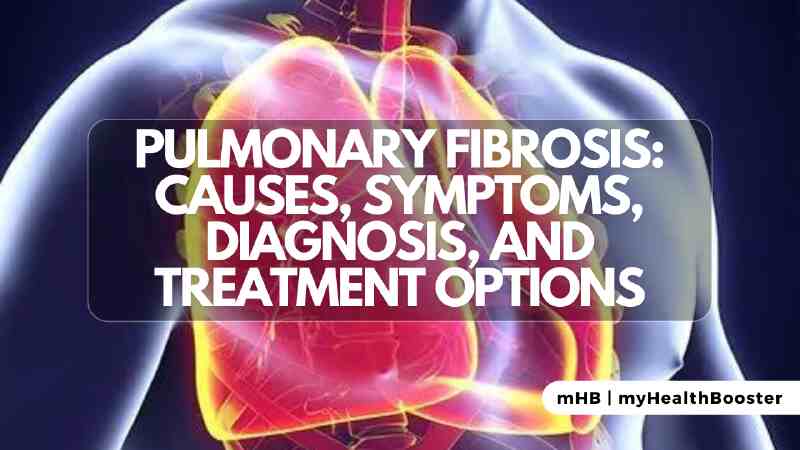Pulmonary fibrosis is a debilitating condition characterized by scarring throughout the lungs, significantly impacting the respiratory system. This article aims to provide comprehensive insights into pulmonary fibrosis, covering its definition, causes, symptoms, diagnosis, treatment options, and prognosis.
What is Pulmonary Fibrosis?
Pulmonary fibrosis involves scarring of the lungs, leading to a poor prognosis, with most patients surviving less than five years. The term “fibrosis” refers to scarring, and when associated with the lungs, it signifies scarring throughout the respiratory organ. Idiopathic pulmonary fibrosis (IPF), a specific form of the disease, is diagnosed when lung scarring occurs without a known cause, typically affecting middle-aged and older adults.
Causes of Pulmonary Fibrosis
Various factors can contribute to the development of pulmonary fibrosis, including chronic inflammatory processes (e.g., sarcoidosis, Wegener’s granulomatosis), infections, exposure to environmental agents (asbestos, silica), ionizing radiation, chronic conditions (lupus, rheumatoid arthritis), and certain medications. In some cases, a heightened immune reaction to inhaled organic dust or occupational chemicals may lead to fibrosis (hypersensitivity pneumonitis). Genetic factors also play a role, as familial idiopathic pulmonary fibrosis is identified when multiple family members are affected.
Symptoms of Pulmonary Fibrosis
Recognizing the symptoms of pulmonary fibrosis is crucial for early diagnosis. Common signs include shortness of breath, chronic dry cough, diminished exercise tolerance, fast, shallow breathing, fatigue, chest discomfort, muscle and joint aches, and unexplained weight loss. “Clubbing” of fingers and toes, characterized by thickening of flesh under the nails, may also occur. Symptoms vary based on the cause and the progression of the disease.
Diagnosis of Pulmonary Fibrosis
Diagnosing pulmonary fibrosis involves a thorough evaluation by a doctor. Medical history, physical examinations, and lung function tests, which may reveal abnormal volumes and reduced diffusing capacity, contribute to the diagnosis. A high-resolution CT scan is often used to visualize lung abnormalities, while lung biopsy may be necessary for confirmation, especially in classical presentations.
Stages of Idiopathic Pulmonary Fibrosis
Staging systems for idiopathic pulmonary fibrosis include mortality risk scoring and the GAP index, which consider factors like age, gender, lung physiology, and recent respiratory hospitalization. These staging systems help estimate the risk and prognosis for individual patients.
Treatment Options for Pulmonary Fibrosis
Current treatment options for idiopathic pulmonary fibrosis are limited. Lung transplantation remains the primary therapeutic option, though ongoing research trials explore drugs like nintedanib and pirfenidone. These drugs show promise in slowing fibrosis progression, but side effects may limit their use. Immune suppressive therapies, such as corticosteroids, are explored for specific types of fibrosis but do not benefit idiopathic pulmonary fibrosis.
Pulmonary Rehabilitation
Pulmonary rehabilitation, including exercise conditioning, nutrition counseling, patient education, and breathing strategies, can improve the quality of life for individuals with chronic breathing problems like pulmonary fibrosis. Smoking cessation, vaccinations, and other supportive measures are recommended for patients with idiopathic pulmonary fibrosis.
Prognosis and Complications
The prognosis for pulmonary fibrosis is generally poor, with survival often less than five years. Complications arise as the disease progresses, leading to heart failure, pulmonary hypertension, and increased risks of blood clots. Depression is also common in individuals facing the challenges of this devastating condition.
Prevention
Preventing idiopathic pulmonary fibrosis is challenging due to its unknown cause. Smoking cessation is crucial, considering the increased frequency of the disease in smokers. Ongoing research aims to identify hereditary markers for a rare form of idiopathic pulmonary fibrosis.
In Summary
Pulmonary fibrosis is a serious and often fatal condition with limited treatment options. Early diagnosis, supportive care, and ongoing research efforts are essential to improve the quality of life for affected individuals and advance our understanding of this complex disease. For additional information and support, individuals can visit pulmonaryfibrosis.org.
References
- American Lung Association. “Pulmonary Fibrosis Symptoms, Causes & Risk Factors.“
- Godfrey, M.K., MD. “Idiopathic Pulmonary Fibrosis Treatment & Management.” Updated: Aug 11, 2016.
- Kolb, M., et al. “Staging of idiopathic pulmonary fibrosis: past, present and future.” European Respiratory Review 2014 23: 220-224; DOI: 10.1183/09059180.00002114
- National Heart, Lung, and Blood Institute. What Is Idiopathic Pulmonary Fibrosis? Updated: Sep 20, 2011.
- Pulmonary Fibrosis Foundation. “About PF.”
- Raghu. et al. “An Official ATS/ERS/JRS/ALAT Clinical Practice Guideline: Treatment of Idiopathic Pulmonary Fibrosis. An Update of the 2011 Clinical Practice Guideline” Am J resp crit care medicine abstract 2015; 192; e3-19.
- Richeldi. et al. “Efficacy and Safety of Nintedanib in Idiopathic Pulmonary Fibrosis.” N Engl J Med 2014; 370:2071-2082.
- Talmadge. et al. “A Phase 3 Trial of Pirfenidone in Patients with Idiopathic Pulmonary Fibrosis.” N Engl J Med 2014; 370:2083-2092.
